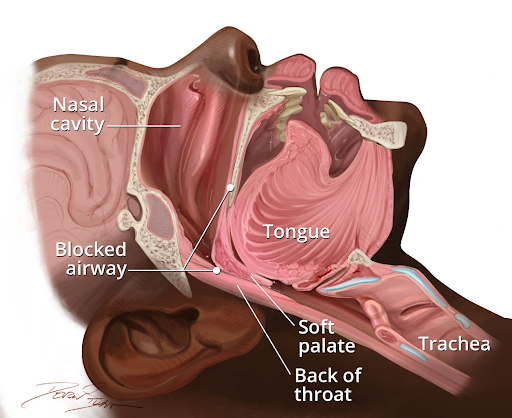
Sleep apnea is a sleep disorder characterized by pauses in breathing or shallow breaths during sleep. These pauses in breathing can occur multiple times per hour and can last from a few seconds to minutes. Sleep apnea disrupts normal sleep patterns and can lead to daytime fatigue, impaired cognitive function, and other health problems if left untreated.
Types of Sleep Apnea:
- Obstructive Sleep Apnea (OSA): This is the most common form of sleep apnea and occurs when the muscles in the throat relax excessively during sleep, causing the airway to become blocked or narrowed. As a result, airflow is reduced or completely blocked, leading to breathing pauses or shallow breathing.
- Central Sleep Apnea (CSA): In CSA, the brain fails to send signals to the muscles responsible for breathing, leading to pauses in breathing during sleep. Unlike OSA, which is caused by physical obstruction of the airway, CSA is primarily a neurological problem.
- Complex Sleep Apnea Syndrome (Treatment-Emergent Central Sleep Apnea): Also known as mixed sleep apnea, this type involves a combination of obstructive and central sleep apnea.
Symptoms
- Loud snoring
- Episodes of breathing cessation during sleep witnessed by another person
- Gasping or choking sensations during sleep
- Excessive daytime sleepiness or fatigue
- Morning headaches
- Difficulty concentrating or memory problems
- Irritability or mood changes
- Decreased libido
- Dry mouth or sore throat upon waking
Risk Factors:
- Obesity or overweight
- Male gender
- Advanced age
- Family history of sleep apnea
- Smoking
- Alcohol or sedative use
- Nasal congestion or obstruction
- Neck circumference (greater than 17 inches in men or 16 inches in women)
- Certain anatomical factors (such as a narrow airway, large tonsils, or a recessed jaw)
Diagnosis:
- Diagnosis of sleep apnea typically involves a sleep study (polysomnography) conducted in a sleep laboratory or home setting. This study monitors various physiological parameters during sleep, including breathing patterns, oxygen levels, heart rate, and brain activity.
-
Treatment:
- Continuous Positive Airway Pressure (CPAP): CPAP therapy involves wearing a mask over the nose or mouth during sleep, which delivers a continuous flow of air to keep the airway open.
- Oral appliances: These devices are designed to reposition the jaw and tongue to keep the airway open during sleep.
- Lifestyle modifications: Losing weight, avoiding alcohol and sedatives, quitting smoking, and sleeping on the side instead of the back can help reduce symptoms of sleep apnea.
- Surgery: In some cases, surgical procedures may be recommended to correct anatomical abnormalities that contribute to sleep apnea.
